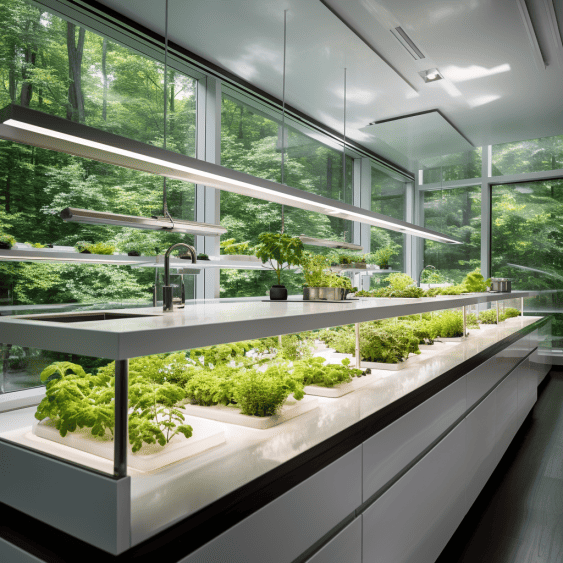Meta Description: Learn how to effortlessly grow 5 easy to grow herbs in hydroponics. Discover the simplicity of hydroponic herb gardening for year-round fresh flavors.
When starting out with hydroponics, stick to beginner-friendly herbs that thrive in water culture. Here are 5 surefire options for first-timers:
Popular basil varieties grow rapidly hydroponically, letting you enjoy pesto, salads and more with homegrown flavor all year.
The vigorously growing mint family, like peppermint and spearmint, also takes off in hydroponic setups with its crisp, refreshing taste. Mexican meals benefit from cilantro, which bolts quickly so plant successively. Subtle chives lend their delicate onion notes to eggs, potatoes, seafood and dips without much fuss. And Mediterranean favorites get an intensity boost from easy-growing oregano and its abundant oils.
These hardy hydroponic plants as herbs transition seamlessly from garden beds to hydroponic systems. They tolerate the transition stress well and don’t have highly specific growing requirements. For beginners looking to get their feet wet without fussy maintenance, starting out with these 5 adaptable herbs paves the way for success. Their forgiving nature makes them perfect foundational crops as you learn the hydroponic ropes.
KEY TAKEAWAY
What are the 5 easy to grow herbs in hydroponics?
Growing herbs in hydroponics offers a simple and efficient way to cultivate a variety of herbs. The top 5 easy-to-grow herbs in hydroponics include basil, mint, parsley, chives, and cilantro (1). With the right setup and care, you can enjoy a continuous supply of fresh and flavorful herbs all year round.
Choosing the Best Hydroponic Systems for Herb Cultivation
When cultivating herbs indoors, beginner gardeners need hydroponic setups that are low-maintenance and user-friendly. Here are some suitable systems:
Deep Water Culture (DWC) offers an extremely simple design – herbs grow directly in containers of aerated, nutrient-rich water. With no complex equipment needed, DWC is inexpensive to set up and maintain. Wick systems work passively as roots draw up water and nutrients through wicks submerged in a reservoir below. No pumps required makes this method simple and affordable too. In Flood and Drain (Ebb and Flow) systems, herbs get flooded with a nourishing bath then allowed to drain repeatedly. The cyclical flooding sustains plants with less frequent monitoring.
Nutrient Film Technique (NFT) channels a thin stream of nutrients across bare roots for excellent oxygenation. And advanced aeroponics setups mist exposed roots with a nutrient solution. But these systems have more complex setup and maintenance.
For those getting started with their first indoor herb garden, simple DWC and wick hydroponics are the clear winners. Their ease and affordability let beginners achieve success without complicated equipment or processes.
After learning about hydroponic systems, it is time to learn about ideal growing conditions.
So let’s keep reading!
Ideal Growing Conditions for Hydroponic Herbs

While soilless, hydroponic herbs still require optimal conditions to flourish (2). Here are the key factors to control:
Ensure ample bright lighting for photosynthesis. Situate plants near sunny windows or supplement with full-spectrum LED grow lights. Monitor ambient air temperature to maintain ideal 70-80°F range for most herbs. Ventilation brings in fresh CO2 and prevents mold, so use small fans if needed. Carefully manage pH between 5.5-6.5 as too low blocks nutrient absorption. And watch EC levels – electrical conductivity measures dissolved nutrients. Target 1.2-1.6 mS/cm for herbs.
Getting the light, temperature, airflow, pH, and nutrition right allows herbs to properly photosynthesize, develop abundant roots, and take up the nutrients they need to grow. Control these environmental inputs for your best indoor crop yet!
Speaking of hydroponic mediums…
Best Hydroponic Mediums for Herbs
The choice of medium for anchoring hydroponic herb roots also matters. Avoid regular potting soil or garden beds – they inhibit water and nutrient flow. Proven mediums include:
- Perlite – Inert volcanic glass that aerates roots well. Often combined with coconut coir for support.
- Expanded clay pellets – Porous, won’t decay or compress over time. Rinse to remove dust first.
- Rockwool – Spun stone fibers hold water while still draining. Easy to use cubes.
- Coco coir – Made from coconut husks, sustainable and renewable. Holds some moisture but not saturated.
- Vermiculite – Light flakes absorb and retain water well. Reusable over time. Rinse before use.
Try different mediums to see which ones your specific herbs thrive in long-term. Let your plants’ performance guide your selection.
If you are learning about hydroponics, then you should learn about pollination too!
Understanding Pollination in Hydroponics
When growing herbs without soil, it helps to understand their pollination needs upfront:
- Self-pollinating herbs like basil, mint, chives and oregano don’t require pollinators or human help to reproduce.
- Cross-pollinating varieties like cilantro and dill need pollen transferred between plants to set seed. Group together.
- Non-pollinating parsley is grown for foliage alone, not seeds.
Knowing plants’ reproductive biology ensures greater success. Some may require hand pollination or proximity for fertile seeds to form. But many culinary herbs happily self-pollinate in hydroponics.
By the way, here’s some tips and tricks for you!
Expert Tips for Hydroponic Herbs at Home
Ready to get growing? Here are pro tips for maximizing herb growth and flavor:
- Start plants from stem cuttings rather than seeds for quicker harvests. Take 4-6 inch basal cuttings just below nodes.
- Use grow lights to extend “daylight” to 16-18 hours a day. Abundant light fuels growth.
- Aerate water with air pumps and stones. Roots suffer without enough oxygen.
- Prune herbs regularly to stimulate bushy, dense growth. Cut just above a leaf node.
- Test nutrients frequently. Top off solutions to maintain optimal levels.
- Harvest often, no more than 30% of plant at once. Frequent pruning boosts yield over time.
Follow these methods meticulously, and your hydroponic herb garden will overflow in no time!
After learning these tips, it is time to learn what mistakes should be avoided.
Let’s keep on reading!
Mistakes to Avoid With Hydroponic Herbs
While hydroponics offers benefits for herbs, beginners should sidestep these common pitfalls:
- Overwatering leads to saturated mediums and root rot from lack of oxygen.
- Incorrect pH or nutrient levels lock out essential elements plants need.
- Insufficient lighting results in spindly, pale growth lacking sun/grow lights.
- Letting air pumps fail suffocates roots with stagnant water.
- Using tiny containers doesn’t provide space for roots to spread out.
- Neglecting pest prevention – herbs can still get aphids, fungus gnats, mites.
Learn how your specific system and plants look when thriving. Detecting problems early prevents casualties down the line!
Speaking of systems, let’s learn the comparison!
Comparing Hydroponic Systems for Herbs
When starting out, it helps to compare options. Here’s how common systems stack up for beginners:
- DWC is extremely beginner-friendly, simple and affordable. But disturbing mature root systems when changing reservoirs may slow growth.
- Wick systems are also easy and cheap. However, limited by reservoir proximity and container size.
- Flood and drain allows larger capacities but requires more complex equipment.
- NFT offers excellent oxygenation but exposes roots and risks clogs.
- Aeroponics maximizes growth rate but is technically demanding and expensive.
Ideally, start with DWC or wick systems to get experience at low cost. Then graduate to advanced setups like aeroponics down the road.
Speaking of hydroponic systems, you should also check out about nutrients in the next section!
Nutrient Requirements for Hydroponic Herbs
In hydroponics, nutrients come from concentrated solutions rather than soil fertilizers. Herbs need:
- Macronutrients – Nitrogen, phosphorus, potassium, calcium, magnesium, sulfur
- Micronutrients – Iron, manganese, boron, zinc, copper, molybdenum, chlorine
Quality hydroponic blends contain all necessary elements properly balanced. Target around 150 ppm nitrogen following mixing guidelines. Purchase formulas designed for hydroponics, not traditional fertilizers. Replace solutions regularly so nutrients remain constantly available.
How about harvesting and caring? Do you care enough for your hydroponic herbs?
Let’s keep on reading to find out more information!
Harvesting and Caring for Hydroponic Herbs
With attentive care, you’ll harvest homegrown herbs in abundance. Here are some tips:
- Snip leaves as needed. Cutting above leaf nodes encourages regrowth.
- Rinse harvested herbs in cold water before use. Gently pat dry with paper towels.
- Change nutrient solutions every 2-3 weeks. Top off evaporating water between changes.
- Transplant mint or other large varieties into bigger containers if root-bound.
- Take stem cuttings to propagate more plants. Transplant or gift extras!
Stay diligent with care and harvesting, and your hydroponic garden provides a perpetual bounty of herbs. Enjoy all the ultra-fresh flavor!
Frequently Asked Questions
Which herbs grow best hydroponically?
Mint, basil, oregano, chives, cilantro, and parsley are great beginner-friendly options that thrive with hydroponic growing methods.
What are 3 things that we can’t grow hydroponically?
Root vegetables like potatoes, carrots, radishes, and beets don’t grow well hydroponically since they require ample substrate material to develop edible roots. Large fruiting plants like tomatoes and squash can become too heavy. Grains like wheat and rice aren’t suited for indoor hydroponic cultivation.
Conclusion
Growing herbs without soil using hydroponics is rewarding and fun for beginners. This guide shared tips for starting out – from easy herb varieties and starter systems to optimized conditions and pro methods. Before you know it, you’ll have homegrown flavor on tap year-round.
What hydroponic herbs are you most excited to try first? Already delving into soilless gardening?
Share your experiences in the comments to keep the hydroponic conversations flowing!
References
- https://hydroponicway.com/best-hydroponics-herbs/#:~:text=Oregano%2C%20basil%2C%20chives%2C%20mint,with%20little%20to%20no%20maintenance.
- https://foodyverticalgarden.com/blogs/resources/127149763-a-quick-guide-to-growing-herbs-indoors-hydroponically
Related Articles
- https://tophydroponicgarden.com/herbs/
- https://tophydroponicgarden.com/guide-to-hydroponic-herb-gardening/
- https://tophydroponicgarden.com/hydroponic-plants/
Was this helpful?

Crystal Erickson is an agriculture enthusiast and writer with a passion for sustainable farming practices and community development. Growing up on a family farm in rural Iowa, Crystal developed a love for the land and a deep appreciation for the hard work and dedication required to make a farm successful.
After completing a degree in Agriculture and Environmental Science from Iowa State University, Crystal began her career as an agricultural journalist, covering stories and issues related to modern farming practices, crop management, and livestock production. She quickly established herself as a respected voice in the industry, known for her insightful reporting and thoughtful analysis.
Over the years, Crystal has written for a variety of publications, including Farm Journal, Successful Farming, and Modern Farmer, as well as contributing to several academic journals focused on sustainable agriculture and community development. Her work has been recognized with numerous awards, including the Iowa Farm Bureau’s Young Farmer Achievement Award and the National Association of Farm Broadcasting’s Farm Broadcaster of the Year.


